


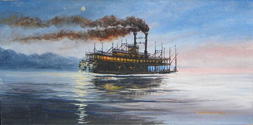
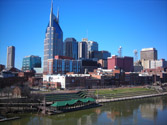
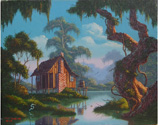
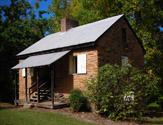









Sunbelt Excursions
Pierce Street
Lynchburg's Out-of-the-Way Connection with African American History
Lynchburg's Out-of-the-Way Connection with African American History

J. P. Bell Company, Lynchburg, Virginia, Circa 1919, Public Domain
By Darrell Laurant
Some tourist attractions shout at us, especially those connected with natural wonders.
But for those wanderers among us who seek out historic sites, more is often required than simply showing up and aiming the camera. An open field without soldiers or cannons might evoke tranquility, but not a Civil War battle. After awhile, one colonial home or cemetery tombstone looks pretty much like another. These, then, are places not so much for the eye, but the imagination. They whisper "Something important happened here. Just try to picture it ..."
The 1300 and 1400 blocks of Pierce Street in Lynchburg, Virginia are a good example. If you go there, you'll see eight historic plaques marching up the street, the thickest congregation of such state-sponsored markers in the Old Dominion. Yet to even want to go there requires some knowledge of the people who inspired those plaques.
There are no interstate highway signs pointing travelers to this intriguing and still thriving neighborhood. In fact, there is no interstate highway -- it is a point of perverse pride with Lynchburgers that their city is one of the largest east of the Rockies not served by one. Moreover, Pierce Street is not a major thoroughfare, but an outwardly unremarkable street tucked away in what is generally referred to as the "inner city." Even the U.S. president for whom it was named -- Franklin Pierce -- has slipped into obscurity.
But, oh, the stories here! And ever so slowly, one bit of national publicity or historic marker at a time, Pierce Street is emerging into the mass consciousness. This is a television documentary waiting only for the right filmmaker.
Some tourist attractions shout at us, especially those connected with natural wonders.
But for those wanderers among us who seek out historic sites, more is often required than simply showing up and aiming the camera. An open field without soldiers or cannons might evoke tranquility, but not a Civil War battle. After awhile, one colonial home or cemetery tombstone looks pretty much like another. These, then, are places not so much for the eye, but the imagination. They whisper "Something important happened here. Just try to picture it ..."
The 1300 and 1400 blocks of Pierce Street in Lynchburg, Virginia are a good example. If you go there, you'll see eight historic plaques marching up the street, the thickest congregation of such state-sponsored markers in the Old Dominion. Yet to even want to go there requires some knowledge of the people who inspired those plaques.
There are no interstate highway signs pointing travelers to this intriguing and still thriving neighborhood. In fact, there is no interstate highway -- it is a point of perverse pride with Lynchburgers that their city is one of the largest east of the Rockies not served by one. Moreover, Pierce Street is not a major thoroughfare, but an outwardly unremarkable street tucked away in what is generally referred to as the "inner city." Even the U.S. president for whom it was named -- Franklin Pierce -- has slipped into obscurity.
But, oh, the stories here! And ever so slowly, one bit of national publicity or historic marker at a time, Pierce Street is emerging into the mass consciousness. This is a television documentary waiting only for the right filmmaker.
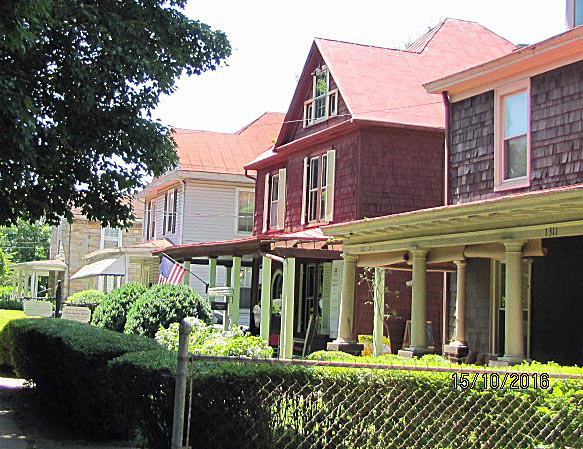
Gail Laurant
Perhaps the best way to emphasize the importance of this street and this block is simply to list some of the luminaries who have set foot there:
Iconic black writer and activist W.E.B. DuBois. James Weldon Johnson, founder and first executive secretary of the National Association for the Advancement of Colored People (NAACP). Walter White, Johnson's successor. U.S. Supreme Court justice Thurgood Marshall. Poet Langston Hughes. Singers Paul Robeson and Marian Anderson. Agricultural pioneer George Washington Carver. Longtime congressman Adam Clayton Powell, who spent the first night of his honeymoon there. World-class tennis players Arthur Ashe and Althea Gibson. Senator Carter Glass, co-founder of the Federal Reserve System. Influential journalist H.L. Mencken. Boxer Joe Louis. Jackie Robinson and Roy Campanella of the Brooklyn Dodgers. Lionel Hampton. Duke Ellington. Maya Angelou. The Rev. Martin Luther King Jr. And, most recently, the street was home to Leland Melvin, who was both a professional football player and a space shuttle astronaut. All of them are part of the rich life story of an out-of-the-way street in an out-of-the-way city.
If you happen to be interested in African American history, Pierce Street is a place you almost have to visit. Or perhaps you've come to the realization that "black history" is really just history, an integral part of the larger American story.
Either way, it's best to start your visit at the Anne Spencer House at 1313 Pierce, a portal into the block's remarkable past. Even without the historic marker in front of it, the house would be easy to pick out from its neighbors because of its distinctive wrap-around porch and the black-and-white checkerboard pattern on the front sidewalk.
Iconic black writer and activist W.E.B. DuBois. James Weldon Johnson, founder and first executive secretary of the National Association for the Advancement of Colored People (NAACP). Walter White, Johnson's successor. U.S. Supreme Court justice Thurgood Marshall. Poet Langston Hughes. Singers Paul Robeson and Marian Anderson. Agricultural pioneer George Washington Carver. Longtime congressman Adam Clayton Powell, who spent the first night of his honeymoon there. World-class tennis players Arthur Ashe and Althea Gibson. Senator Carter Glass, co-founder of the Federal Reserve System. Influential journalist H.L. Mencken. Boxer Joe Louis. Jackie Robinson and Roy Campanella of the Brooklyn Dodgers. Lionel Hampton. Duke Ellington. Maya Angelou. The Rev. Martin Luther King Jr. And, most recently, the street was home to Leland Melvin, who was both a professional football player and a space shuttle astronaut. All of them are part of the rich life story of an out-of-the-way street in an out-of-the-way city.
If you happen to be interested in African American history, Pierce Street is a place you almost have to visit. Or perhaps you've come to the realization that "black history" is really just history, an integral part of the larger American story.
Either way, it's best to start your visit at the Anne Spencer House at 1313 Pierce, a portal into the block's remarkable past. Even without the historic marker in front of it, the house would be easy to pick out from its neighbors because of its distinctive wrap-around porch and the black-and-white checkerboard pattern on the front sidewalk.
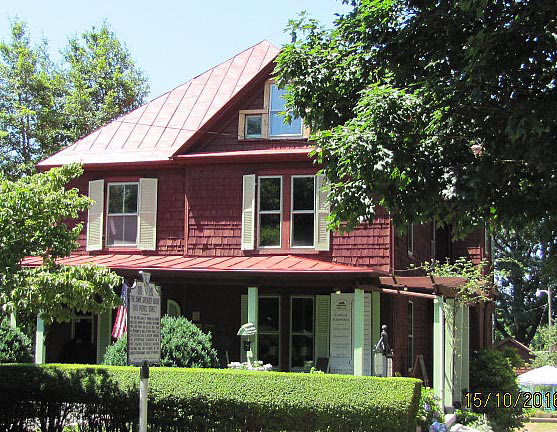
Gail Laurant
That's probably what W.E.B. DuBois saw as he made his way to the Spencers' front door one afternoon not long after the end of World War I. DuBois, in Lynchburg to fulfill a speaking engagement at Virginia Seminary & College, was appalled when his hosts offered him a metal washtub in response to his request for a shower. Embarrassed, the college officials directed him to the Spencers' house several blocks away, where Edward Spencer - like his wife, Anne, a Seminary graduate - had installed indoor plumbing and hot water.
The author of the best-selling book The Souls of Black Folk and a co-founder of the NAACP, DuBois was one of the most influential African American voices of his time. To have him suddenly appear unannounced on the Spencers' porch must have been like receiving an unexpected visit from Oprah Winfrey today. But DuBois got his shower, and he spread the word that the Spencer's home was a congenial oasis in the segregated wilderness between Washington and Atlanta.
Not long afterward, James Weldon Johnson, a noted author, poet and songwriter, who was named the first Executive Secretary of the NAACP, came down to Lynchburg to help Anne start a chapter there. He and the Spencers became close friends, and Johnson's successor, Walter White, also made several trips to 1313 Pierce.
This distinguished trio was then followed over the years by many of the major figures of the Harlem Renaissance. And Anne Spencer soon became not only a hostess to these black intellectuals and writers, but one of them.
It was James Weldon Johnson who discovered that Anne had been composing poetry of rare depth, wisdom and sensitivity, some of it scrawled spontaneously on the interior walls of her house. Johnson shared some of Anne's work with publisher friends in New York, and she ultimately became the only African-American poet included in the Norton Anthology of Literature by Women.
Much of her poetry was written inside Edankraal, the small cottage Edward built for her in the garden behind the house. If you go to 1313 Pierce, you might find Spencer's granddaughter, Shaun Spencer Hester, on the premises to welcome you. If not, you are free to stroll down the driveway at one side and down into the garden itself.
The author of the best-selling book The Souls of Black Folk and a co-founder of the NAACP, DuBois was one of the most influential African American voices of his time. To have him suddenly appear unannounced on the Spencers' porch must have been like receiving an unexpected visit from Oprah Winfrey today. But DuBois got his shower, and he spread the word that the Spencer's home was a congenial oasis in the segregated wilderness between Washington and Atlanta.
Not long afterward, James Weldon Johnson, a noted author, poet and songwriter, who was named the first Executive Secretary of the NAACP, came down to Lynchburg to help Anne start a chapter there. He and the Spencers became close friends, and Johnson's successor, Walter White, also made several trips to 1313 Pierce.
This distinguished trio was then followed over the years by many of the major figures of the Harlem Renaissance. And Anne Spencer soon became not only a hostess to these black intellectuals and writers, but one of them.
It was James Weldon Johnson who discovered that Anne had been composing poetry of rare depth, wisdom and sensitivity, some of it scrawled spontaneously on the interior walls of her house. Johnson shared some of Anne's work with publisher friends in New York, and she ultimately became the only African-American poet included in the Norton Anthology of Literature by Women.
Much of her poetry was written inside Edankraal, the small cottage Edward built for her in the garden behind the house. If you go to 1313 Pierce, you might find Spencer's granddaughter, Shaun Spencer Hester, on the premises to welcome you. If not, you are free to stroll down the driveway at one side and down into the garden itself.
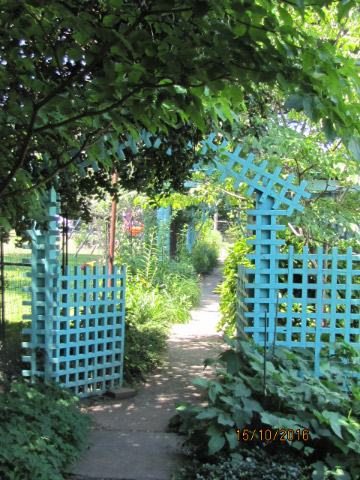
Gail Laurant
For eight years after Anne Spencer's death in 1975, this garden sat abandoned and eventually overgrown. It was an all-white, well-to-do Lynchburg garden club that recognized the significance of that space and spent countless hours returning it to the peaceful and contemplative refuge that Anne had created. A black, cast-iron African head once again spits water into a small pond, a gift to the Spencers from W.E.B. DuBois.
The house itself has not been restored so much as preserved, much of the work done by granddaughter Hester.
"I can feel Anne Spencer's spirit in this place," said another famous poet, the late Maya Angalou, when she visited. Which was not surprising, because 1313 Pierce has been frozen in time. Both floors are rich in memories and the decorating quirks of the owners. Shaun Spencer Hester conducts her tours not as a well-informed but ultimately distant historian, but as a family member.
The daughter of Anne's son Chauncey, Shaun returned to Lynchburg after years of living in Los Angeles and Washington, drawn by the need to save and share her grandmother's house and life. She has also involved herself in the larger preservation efforts along the block, including the renovation of an ancient store on the corner of 13th Street and Pierce and the creation of a "Harlem Renaissance Festival" on the street each summer.
"We'd like to turn the store into a museum," she says, "and maybe a place where visiting writers can stay and work."
If so, these visitors will be surrounded by even more history, for Anne Spencer is only the beginning of the street's heritage.
A woman named Amaza Meredith lived on the second floor of that store for a time. The product of biracial parents, she inherited her father's ability as an architect and refused to be discouraged when all of Virginia's architectural schools turned her away because of her race and gender. She graduated from Columbia University in New York, built up her credibility by doing projects for friends, and ultimately became head of the art department at Virginia State University. There, she designed and built a house called Azurest South that became nationally known for its modernistic innovations.
The store is also connected with Ota Benga, a pygmy from the Congo who became the center of an international outcry when he was exhibited in a primate house cage at the Bronx Zoo in 1906. Evidence remains cloudy as to whether he lived at the store during the six years he spent in Lynchburg, but Ota Benga frequented the block and was tutored in English by Anne Spencer. (See Bachelor's Retreat: An Historic South Carolina Community Like No Other for more information on Ota Benga and Samuel Phillips Verner who brought him to the USA.)
Chauncey Spencer, who grew up on Pierce and spent his last years at 1306, was a pioneer black aviator. In 1938, he and Dale White flew a rickety small plane from Chicago to Washington (crash-landing twice along the way) to argue for the formation of an African-American air corps. That produced a meeting with then-Senator Harry Truman, who became a staunch supporter, and led to the evolution of the famed Tuskegree Airmen.
Perhaps the best-known historic figure connected with Pierce Street, however, was Dr. R. Walter Johnson, a family physician and one-time college football star who built a clay tennis court at 1422 Pierce and trained dozens of youngsters, most of them black and disadvantaged, at an informal summer camp.
Those students included Arthur Ashe and Althea Gibson, both of whom credited Johnson as being a major factor in their later international success. And Johnson's myriad national connections transcended tennis to include Brooklyn Dodger stars Robinson and Campanella, world heavyweight champion Joe Louis and jazz musicians like Ellington and Hampton.
In 2007, Johnson was posthumously inducted into to the International Tennis Hall of Fame.
As with Anne Spencer, the ongoing revival of Johnson's home and court - both of which had fallen into disrepair - is being orchestrated by a group of his grandchildren. "We want to start with the court," said JoLynn Johnson Smith of Richmond, "and then turn the house into a museum."
Before Johnson, that house was occupied by Frank Trigg, who was born into slavery in Richmond. After the loss of an arm in a farming accident prevented him from performing manual labor, Trigg immersed himself in books and later became the president of three African-American colleges.
Finally, Pierce Street was the base of operations for C.W. Seay, who spent 30 years as principal of the segregated Dunbar High School and sent scores of his students on to college - including a number of Ivy League schools. Dunbar graduates during his tenure included Carl Anderson (Judas in the rock musical Jesus Christ Superstar and later a soap opera star and recording artist), Christopher Edley Sr. (head of the United Negro College Fund), Mary Hatwood Futrell (president of the National Education Association) and Vivian Pinn, director of women's health research at the National Institutes of Health.
Lynchburg's relatively compact downtown also includes two other historic sites that complement Pierce Street: the Old City Cemetery and the Legacy Museum of black history. Sandusky (a Civil War site) and Point of Honor (built by Patrick Henry's personal physician) are nearby, and the city offers plenty of motels, hotels, bed-and-breakfast lodging and places to eat and drink.
At the Visitor's Center at the corner of Church and 12th streets, you will find information about Pierce Street and the other attractions. It may enrich your experience.
The city is also the home to four colleges - Liberty University, Lynchburg College, Randolph College and Virginia University of Lynchburg (once Virginia Seminary), and is a short drive from the Blue Ridge mountains in south central Virginia.
BIBLIOGRAPHY
Adrian Higgins, "Where the Harlem Renaissance Bloomed in Virginia," The Washington Post, July 28, 2014
SOURCES
In-person interview with Shaun Spencer Hester, April 1, 2016
Telephone conversation with Shaun Spencer Hester, June 8, 2016
Telephone conversations with JoLynn Johnson Smith, April 7 and June 16, 2016
Author: Darrell Laurant. Published November 5, 2016.
The house itself has not been restored so much as preserved, much of the work done by granddaughter Hester.
"I can feel Anne Spencer's spirit in this place," said another famous poet, the late Maya Angalou, when she visited. Which was not surprising, because 1313 Pierce has been frozen in time. Both floors are rich in memories and the decorating quirks of the owners. Shaun Spencer Hester conducts her tours not as a well-informed but ultimately distant historian, but as a family member.
The daughter of Anne's son Chauncey, Shaun returned to Lynchburg after years of living in Los Angeles and Washington, drawn by the need to save and share her grandmother's house and life. She has also involved herself in the larger preservation efforts along the block, including the renovation of an ancient store on the corner of 13th Street and Pierce and the creation of a "Harlem Renaissance Festival" on the street each summer.
"We'd like to turn the store into a museum," she says, "and maybe a place where visiting writers can stay and work."
If so, these visitors will be surrounded by even more history, for Anne Spencer is only the beginning of the street's heritage.
A woman named Amaza Meredith lived on the second floor of that store for a time. The product of biracial parents, she inherited her father's ability as an architect and refused to be discouraged when all of Virginia's architectural schools turned her away because of her race and gender. She graduated from Columbia University in New York, built up her credibility by doing projects for friends, and ultimately became head of the art department at Virginia State University. There, she designed and built a house called Azurest South that became nationally known for its modernistic innovations.
The store is also connected with Ota Benga, a pygmy from the Congo who became the center of an international outcry when he was exhibited in a primate house cage at the Bronx Zoo in 1906. Evidence remains cloudy as to whether he lived at the store during the six years he spent in Lynchburg, but Ota Benga frequented the block and was tutored in English by Anne Spencer. (See Bachelor's Retreat: An Historic South Carolina Community Like No Other for more information on Ota Benga and Samuel Phillips Verner who brought him to the USA.)
Chauncey Spencer, who grew up on Pierce and spent his last years at 1306, was a pioneer black aviator. In 1938, he and Dale White flew a rickety small plane from Chicago to Washington (crash-landing twice along the way) to argue for the formation of an African-American air corps. That produced a meeting with then-Senator Harry Truman, who became a staunch supporter, and led to the evolution of the famed Tuskegree Airmen.
Perhaps the best-known historic figure connected with Pierce Street, however, was Dr. R. Walter Johnson, a family physician and one-time college football star who built a clay tennis court at 1422 Pierce and trained dozens of youngsters, most of them black and disadvantaged, at an informal summer camp.
Those students included Arthur Ashe and Althea Gibson, both of whom credited Johnson as being a major factor in their later international success. And Johnson's myriad national connections transcended tennis to include Brooklyn Dodger stars Robinson and Campanella, world heavyweight champion Joe Louis and jazz musicians like Ellington and Hampton.
In 2007, Johnson was posthumously inducted into to the International Tennis Hall of Fame.
As with Anne Spencer, the ongoing revival of Johnson's home and court - both of which had fallen into disrepair - is being orchestrated by a group of his grandchildren. "We want to start with the court," said JoLynn Johnson Smith of Richmond, "and then turn the house into a museum."
Before Johnson, that house was occupied by Frank Trigg, who was born into slavery in Richmond. After the loss of an arm in a farming accident prevented him from performing manual labor, Trigg immersed himself in books and later became the president of three African-American colleges.
Finally, Pierce Street was the base of operations for C.W. Seay, who spent 30 years as principal of the segregated Dunbar High School and sent scores of his students on to college - including a number of Ivy League schools. Dunbar graduates during his tenure included Carl Anderson (Judas in the rock musical Jesus Christ Superstar and later a soap opera star and recording artist), Christopher Edley Sr. (head of the United Negro College Fund), Mary Hatwood Futrell (president of the National Education Association) and Vivian Pinn, director of women's health research at the National Institutes of Health.
Lynchburg's relatively compact downtown also includes two other historic sites that complement Pierce Street: the Old City Cemetery and the Legacy Museum of black history. Sandusky (a Civil War site) and Point of Honor (built by Patrick Henry's personal physician) are nearby, and the city offers plenty of motels, hotels, bed-and-breakfast lodging and places to eat and drink.
At the Visitor's Center at the corner of Church and 12th streets, you will find information about Pierce Street and the other attractions. It may enrich your experience.
The city is also the home to four colleges - Liberty University, Lynchburg College, Randolph College and Virginia University of Lynchburg (once Virginia Seminary), and is a short drive from the Blue Ridge mountains in south central Virginia.
BIBLIOGRAPHY
Adrian Higgins, "Where the Harlem Renaissance Bloomed in Virginia," The Washington Post, July 28, 2014
SOURCES
In-person interview with Shaun Spencer Hester, April 1, 2016
Telephone conversation with Shaun Spencer Hester, June 8, 2016
Telephone conversations with JoLynn Johnson Smith, April 7 and June 16, 2016
Author: Darrell Laurant. Published November 5, 2016.
Copyright
Southern Edition
All Rights Reserved
Southern Edition
All Rights Reserved
All materials contained on this site, including text and images, are protected by copyright laws and may not be reproduced without prior written permission from the publisher. Where applicable, use of some items contained on this site may require permission from other copyright owners.
Fair Use of text from SouthernEdition.com is permitted to the extent allowed by copyright law. Proper citation is requested. Please use this guide when citing a Southern Edition article.
Contact Greg Freeman or SouthernEdition.comFair Use of text from SouthernEdition.com is permitted to the extent allowed by copyright law. Proper citation is requested. Please use this guide when citing a Southern Edition article.